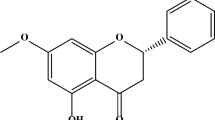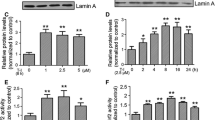Abstract
6-Hydroxydopamine (6-OHDA) induces the production of reactive oxygen species (ROS) that are associated with various neurodegenerative diseases such as Parkinson’s disease. 3,3′,4′,7-Tetrahydroxyflavone (fisetin), a plant flavonoid has a variety of physiological effects such as antioxidant activity. In this study, we investigated the molecular mechanism of the neuroprotective effects of fisetin against 6-OHDA-induced cell death in human neuroblastoma SH-SY5Y cells. 6-OHDA-mediated cell toxicity was reduced in a fisetin concentration-dependent manner. 6-OHDA-mediated elevation of the expression of the oxidative stress-related genes such as hemeoxygenase-1, NAD(P)H dehydrogenase quinone 1, NF-E2-related factor 2, and γ-glutamate-cysteine ligase modifier was suppressed by fisetin. Fisetin also lowered the ratio of the proapoptotic Bax protein and the antiapoptotic Bcl-2 protein in SH-SY5Y cells. Moreover, fisetin effectively suppressed 6-OHDA-mediated activation of caspase-3 and caspase-9, which leads to the cell death, while, 6-OHDA-induced caspase-3/7 activity was lowered. Furthermore, fisetin activated the PI3K-Akt signaling, which inhibits the caspase cascade, and fisetin-mediated inhibition of 6-OHDA-induced cell death was negated by the co-treatment with an Akt inhibitor. These results indicate that fisetin protects 6-OHDA-induced cell death by activating PI3K-Akt signaling in human neuronal SH-SY5Y cells. This is the first report that the PI3K-Akt signaling is involved in the fisetin-protected ROS-mediated neuronal cell death.







Similar content being viewed by others
Abbreviations
- PD:
-
Parkinson’s disease
- ROS:
-
Reactive oxygen species
- 6-OHDA:
-
6-Hydroxydopamine
- fisetin:
-
3,3′,4′,7-Tetrahydroxyflavone
- ERK:
-
Extracellular signal-regulated kinase
- HRP:
-
Horseradish peroxidase
- DCDFA:
-
2′,7′-Dichlorofluorescein diacetate
- DMEM:
-
Dulbecco’s modified Eagle’s medium
- LDH:
-
Lactate dehydrogenase
- qPCR:
-
Quantitative PCR
- HO-1:
-
Hemeoxygenase-1
- NQO1:
-
NAD(P)H dehydrogenase quinone 1
- NRF2:
-
NF-E2-related factor 2
- GCLM:
-
γ-glutamate-cysteine ligase modifier
- PI3K:
-
Phosphoinositide 3-kinase
- Akti:
-
Akt inhibitor
References
Liu Z, Zhou T, Ziegler AC, Dimitrion P, Zuo L (2017) Oxidative stress in neurodegenerative diseases: from molecular mechanisms to clinical applications. Oxid Med Cell Longev 2017:2525967
Farrer MJ (2006) Genetics of Parkinson disease: paradigm shifts and future prospects. Nat Rev Genet 7:306–318
Bekris LM, Mata IF, Zabetian CP (2010) The genetics of Parkinson disease. J Geriatr Psychiatry Neurol 23:228–242
Dias V, Junn E, Mouradian MM (2013) The role of oxidative stress in Parkinson’s disease. J Parkinsons Dis 3:461–491
Lehmensiek V, Tan EM, Liebau S, Lenk T, Zettlmeisl H, Schwarz J, Storch A (2006) Dopamine transporter-mediated cytotoxicity of 6-hydroxydopamine in vitro depends on expression of mutant alpha-synucleins related to Parkinson’s disease. Neurochem Int 48:329–340
Yuan WJ, Yasuhara T, Shingo T, Muraoka K, Agari T, Kameda M, Uozumi T, Tajiri N, Morimoto T, Jing M, Baba T, Wang F, Leung H, Matsui T, Miyoshi Y, Date I (2008) Neuroprotective effects of edaravone-administration on 6-OHDA-treated dopaminergic neurons. BMC Neurosci 9:75
Henning J, Strauss U, Wree A, Gimsa J, Rolfs A, Benecke R, Gimsa U (2008) Differential astroglial activation in 6-hydroxydopamine models of Parkinson’s disease. Neurosci Res 62:246–253
Radi E, Formichi P, Battisti C, Federico A (2014) Apoptosis and oxidative stress in neurodegenerative diseases. J Alzheimers Dis 42(Suppl 3):S125–S152
Filograna R, Beltramini M, Bubacco L, Bisaglia M (2016) Anti-oxidants in parkinson’s disease therapy: a critical point of view. Curr Neuropharmacol 14:260–271
Connolly BS, Lang AE (2014) Pharmacological treatment of Parkinson disease: a review. JAMA 311:1670–1683
Hughes KC, Gao X, Kim IY, Rimm EB, Wang M, Weisskopf MG, Schwarzschild MA, Ascherio A (2016) Intake of antioxidant vitamins and risk of Parkinson’s disease. Mov Disord 31:1909–1914
Mazo NA, Echeverria V, Cabezas R, Avila-Rodriguez M, Aliev G, Leszek J, Barreto GE (2017) Medicinal plants as protective strategies against Parkinson’s disease. Curr Pharm Des 23:4180–4188
Di Carlo G, Mascolo N, Izzo AA, Capasso F (1999) Flavonoids: old and new aspects of a class of natural therapeutic drugs. Life Sci 65:337–353
Kawser Hossain M, Abdal Dayem A, Han J, Yin Y, Kim K, Kumar Saha S, Yang GM, Choi HY, Cho SG (2016) Molecular mechanisms of the anti-obesity and anti-diabetic properties of flavonoids. Int J Mol Sci 17:569
Funakoshi-Tago M, Nakamura K, Tago K, Mashino T, Kasahara T (2011) Anti-inflammatory activity of structurally related flavonoids, apigenin, luteolin and fisetin. Int Immunopharmacol 11:1150–1159
Birt DF, Hendrich S, Wang W (2001) Dietary agents in cancer prevention: flavonoids and isoflavonoids. Pharmacol Ther 90:157–177
Nijveldt RJ, van Nood E, van Hoorn DE, Boelens PG, van Norren K, van Leeuwen PA (2001) Flavonoids: a review of probable mechanisms of action and potential applications. Am J Clin Nutr 74:418–425
Shukla S, Gupta S (2006) Molecular targets for apigenin-induced cell cycle arrest and apoptosis in prostate cancer cell xenograft. Mol Cancer Ther 5:843–852
Sagara Y, Vanhnasy J, Maher P (2004) Induction of PC12 cell differentiation by flavonoids is dependent upon extracellular signal-regulated kinase activation. J Neurochem 90:1144–1155
Yen JH, Wu PS, Chen SF, Wu MJ (2017) Fisetin protects PC12 cells from tunicamycin-mediated cell death via reactive oxygen species scavenging and modulation of Nrf2-driven gene expression, SIRT1 and MAPK signaling in PC12 cells. Int J Mol Sci 18(4):852
Zheng LT, Ock J, Kwon BM, Suk K (2008) Suppressive effects of flavonoid fisetin on lipopolysaccharide-induced microglial activation and neurotoxicity. Int Immunopharmacol 8:484–494
Maher P, Akaishi T, Abe K (2006) Flavonoid fisetin promotes ERK-dependent long-term potentiation and enhances memory. Proc Natl Acad Sci USA 103:16568–16573
Prakash D, Sudhandiran G (2015) Dietary flavonoid fisetin regulates aluminium chloride-induced neuronal apoptosis in cortex and hippocampus of mice brain. J Nutr Biochem 26:1527–1539
Patel MY, Panchal HV, Ghribi O, Benzeroual KE (2012) The neuroprotective effect of fisetin in the MPTP model of Parkinson’s disease. J Parkinsons Dis 2:287–302
Zbarsky V, Datla KP, Parkar S, Rai DK, Aruoma OI, Dexter DT (2005) Neuroprotective properties of the natural phenolic antioxidants curcumin and naringenin but not quercetin and fisetin in a 6-OHDA model of Parkinson’s disease. Free Radic Res 39:1119–1125
Nakao Y, Yoshihara H, Fujimori K (2016) Suppression of very early stage of adipogenesis by baicalein, a plant-derived flavonoid through reduced Akt-C/EBPα-GLUT4 signaling-mediated glucose uptake in 3T3-L1 adipocytes. PLoS ONE 11:e0163640
Will M, Qin AC, Toy W, Yao Z, Rodrik-Outmezguine V, Schneider C, Huang X, Monian P, Jiang X, de Stanchina E, Baselga J, Liu N, Chandarlapaty S, Rosen N (2014) Rapid induction of apoptosis by PI3K inhibitors is dependent upon their transient inhibition of RAS-ERK signaling. Cancer Discov 4:334–347
Crotty GF, Ascherio A, Schwarzschild MA (2017) Targeting urate to reduce oxidative stress in Parkinson disease. Exp Neurol 298:210–224
Jager AK, Saaby L (2011) Flavonoids and the CNS. Molecules 16:1471–1485
Diniz TC, Silva JC, de Lima-Saraiva SR, Ribeiro FP, Pacheco AG, de Freitas RM, Quintans-Junior LJ, Quintans Jde S, Mendes RL, Almeida JR (2015) The role of flavonoids on oxidative stress in epilepsy. Oxid Med Cell Longev 2015:171756
Wang ZY, Liu JY, Yang CB, Malampati S, Huang YY, Li MX, Li M, Song JX (2017) Neuroprotective natural products for the treatment of parkinson’s disease by targeting the autophagy-lysosome pathway: a systematic review. Phytother Res 31:1119–1127
Gabor M, Eperjessy E (1966) Antibacterial effect of fisetin and fisetinidin. Nature 212:1273
Adhami VM, Syed DN, Khan N, Mukhtar H (2012) Dietary flavonoid fisetin: a novel dual inhibitor of PI3K/Akt and mTOR for prostate cancer management. Biochem Pharmacol 84:1277–1281
Watanabe M, Hisatake M, Fujimori K (2015) Fisetin suppresses lipid accumulation in mouse adipocytic 3T3-L1 cells by repressing GLUT4-mediated glucose uptake through inhibition of mTOR-C/EBPα signaling. J Agric Food Chem 63:4979–4987
Currais A, Farrokhi C, Dargusch R, Armando A, Quehenberger O, Schubert D, Maher P (2017) Fisetin reduces the impact of aging on behavior and physiology in the rapidly aging SAMP8 mouse. J Gerontol A Biol Sci Med Sci. https://doi.org/10.1093/gerona/glx104
Currais A, Prior M, Dargusch R, Armando A, Ehren J, Schubert D, Quehenberger O, Maher P (2014) Modulation of p25 and inflammatory pathways by fisetin maintains cognitive function in Alzheimer’s disease transgenic mice. Aging Cell 13:379–390
Khan N, Afaq F, Khusro FH, Mustafa Adhami V, Suh Y, Mukhtar H (2012) Dual inhibition of phosphatidylinositol 3-kinase/Akt and mammalian target of rapamycin signaling in human nonsmall cell lung cancer cells by a dietary flavonoid fisetin. Int J Cancer 130:1695–1705
Cai J, Yang J, Jones DP (1998) Mitochondrial control of apoptosis: the role of cytochrome c. Biochim Biophys Acta 1366:139–149
Vander Heiden MG, Thompson CB (1999) Bcl-2 proteins: regulators of apoptosis or of mitochondrial homeostasis? Nat Cell Biol 1:E209–E216
Tortosa A, Lopez E, Ferrer I (1997) Bcl-2 and Bax proteins in lewy bodies from patients with Parkinson’s disease and diffuse lewy body disease. Neurosci Lett 238:78–80
Raisova M, Hossini AM, Eberle J, Riebeling C, Wieder T, Sturm I, Daniel PT, Orfanos CE, Geilen CC (2001) The Bax/Bcl-2 ratio determines the susceptibility of human melanoma cells to CD95/Fas-mediated apoptosis. J Invest Dermatol 117:333–340
Chen PY, Ho YR, Wu MJ, Huang SP, Chen PK, Tai MH, Ho CT, Yen JH (2015) Cytoprotective effects of fisetin against hypoxia-induced cell death in PC12 cells. Food Funct 6:287–296
Martelli AM, Faenza I, Billi AM, Manzoli L, Evangelisti C, Fala F, Cocco L (2006) Intranuclear 3′-phosphoinositide metabolism and Akt signaling: new mechanisms for tumorigenesis and protection against apoptosis? Cell Signal 18:1101–1107
Brader S, Eccles SA (2004) Phosphoinositide 3-kinase signalling pathways in tumor progression, invasion and angiogenesis. Tumori 90:2–8
Author information
Authors and Affiliations
Corresponding author
Ethics declarations
Conflict of interest
The authors declare that they have no conflict of interest.
Rights and permissions
About this article
Cite this article
Watanabe, R., Kurose, T., Morishige, Y. et al. Protective Effects of Fisetin Against 6-OHDA-Induced Apoptosis by Activation of PI3K-Akt Signaling in Human Neuroblastoma SH-SY5Y Cells. Neurochem Res 43, 488–499 (2018). https://doi.org/10.1007/s11064-017-2445-z
Received:
Revised:
Accepted:
Published:
Issue Date:
DOI: https://doi.org/10.1007/s11064-017-2445-z




